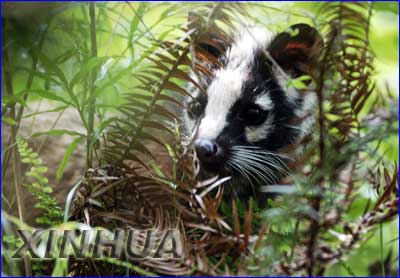Masked Palm Civet (Paguma larvata) - Wiki Masked Palm Civet
From Wikipedia, the free encyclopedia
[Photo] Masked Palm Civet (Paguma larvata). Source: http://unn.people.com.cn/GB/channel2/3/30/3633/3634/200305/28/260807.html
The Masked Palm Civet or Himalayan Palm Civet (Paguma larvata) is a species of civet spread across South Asia and Southeast Asia, which in recent times became known in connection with SARS.
Characteristics
In appearance the Masked Palm Civet resembles other civets. Its fur is orange-brown to gray, and has no spots or stripes, unlike most other related species. Only the feet are darker, often black. The face has a black and white variation: a white strip stretches from the forehead to the nose, surrounded by two black stripes, but the eyes are surrounded by white spots. The cheeks and the sides of the nose are black. The main body varies from 51 to 76 cm (20 to 28 in) in length, to which is added a tail of 51 to 63 cm (20 to 25 in). It was between 3.6 and 6 kg (8 and 13.2 lb).
Habitat and range
The Masked Palm Civet lives in forests, especially tropical rainforest and temperate deciduous forest. It ranges from Pakistan to Southeast Asia and China. It is also found on several islands, such as Borneo, Sumatra, Taiwan, and the Andaman and Nicobar chains. It is not native to Japan, but it was brought there at the beginning of the 20th century.
The principal danger for the Masked Palm Civet is continued habitat destruction. However, because of its large range, it is not considered endangered.
Life
The Masked Palm Civet is a nocturnal solitary predator, which stays principally in trees. During the day, it sleeps in the treetops. When alarmed, the animal sprays a secretion from its anal gland against the predator. The spray is similar in function to that of a skunk, and its conspicuousness serves to deter other predators.
The Masked Palm Civet is an omnivore, but the largest component of its diet is fruit. In addition it eats small vertebrates (such as squirrels and birds) as well as insects.
The female can bear young twice per year, in litters of one to four. The young grow to the size of an adult in about three months. Otherwise little detail is known about the reproductive cycle.
Connection with SARS
In parts of China the Masked Palm Civet is hunted for its meat and eaten. Through this, according to many virologists, the SARS coronavirus was first brought to humans. In May 2003 the virus was isolated in several Masked Palm Civets. There remains the possibility that the Masked Palm Civets were not the original carriers of the virus either, but received it from other, unknown animals.
Conservation
In Hong Kong, it is a protected species under Wild Animals Protection Ordinance Cap 170.
http://en.wikipedia.org/wiki/Masked_Palm_Civet
| The text in this page is based on the copyrighted Wikipedia article shown in above URL. It is used under the GNU Free Documentation License. You may redistribute it, verbatim or modified, providing that you comply with the terms of the GFDL. |
